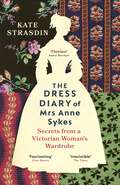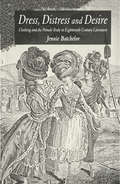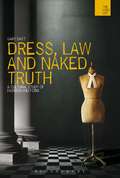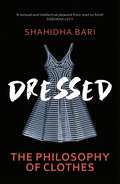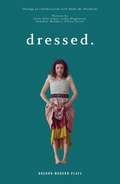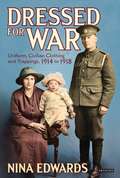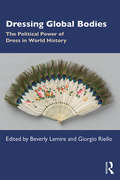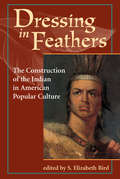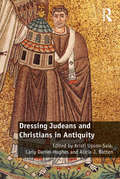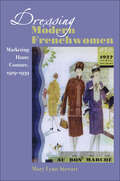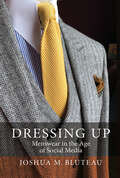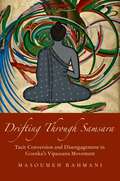- Table View
- List View
The Dress Diary of Mrs Anne Sykes: Secrets from a Victorian Woman’s Wardrobe
by Kate StrasdinThe hidden fabric of a Victorian woman's life told through her unique scrapbook.In 1838, Anne Sykes was given a diary on her wedding day. Using it to collect snippets of fabric, she created a record of her life and times. Nearly two hundred years later, the diary fell into the hands of fashion historian Kate Strasdin who spent the next six years unravelling the secrets contained within its pages.Piece by piece, she charts Anne's life and times. Fragments of cloth become windows into Victorian life: pirates in Borneo, the complicated etiquette of mourning, poisonous dyes, the British Empire in full swing, rioting over working conditions and the terrible human cost of Britain's cotton industry. Through the evidence of waistcoats, ball gowns and mourning outfits, Strasdin lays bare the whole of human experience in the most intimate of mediums: the clothes we choose to wear.‘Flawless’ Amber Butchart‘Fascinating’ Clare Hunter‘Irresistible’ The Times
Dress, Distress and Desire: Clothing and the Female Body in Eighteenth-Century Literature
by J. BatchelorDress, Distress and Desire explores representations of sartorial experience in eighteenth-century literature. Batchelor's study brings together for the first time canonical and non-canonical texts including novels, conduct books and women's magazines to investigate the pressures that the growth of the fashion market placed on conceptions of female virtue and propriety. It shows how dress dispelled the sentimental myth that the body acted as a moral index and enabled the women reader to resist some of sentimental literature's more prescriptive advice.
Dress, Law and Naked Truth: A Cultural Study of Fashion and Form (The WISH List)
by Gary WattWhy are civil authorities in so-called liberal democracies affronted by public nudity and the Islamic full-face 'veil'? Why is law and civil order so closely associated with robes, gowns, suits, wigs and uniforms? Why is law so concerned with the 'evident' and the need for justice to be 'seen' to be done? Why do we dress and obey dress codes at all? In this, the first ever study devoted to the many deep cultural connections between dress and law, the author addresses these questions and more. His responses flow from the radical thesis that 'law is dress and dress is law'.Engaging with sources from The Epic of Gilgamesh to Shakespeare, Carlyle, Dickens and Damien Hirst, Professor Watt draws a revealing history of dress and civil order and offers challenging conclusions about the nature of truth and the potential for individuals to fit within the forms of civil life.
Dressed: The Secret Life of Clothes
by Dr Shahidha BariWe are all dressed. But how often do we pause to think about the place of our clothes in our lives? What unconscious thoughts do we express when we dress every day? Can memories, meaning and ideas be wrapped up in a winter coat?These are the questions that interest Shahidha Bari, as she explores the secret language of our clothes. Ranging freely through literature, art, film and philosophy, Dressed tracks the hidden power of clothes in our culture and our daily lives. From the depredations of violence and ageing to our longing for freedom, love and privacy, from the objectification of women to the crisis of masculinity, each garment exposes a fresh dilemma. Item by item, the story of ourselves unravels. Evocative, enlightening and dazzlingly original, Dressed is not just about clothes as objects of fashion or as a means of self-expression. This is a book about the deepest philosophical questions of who we are, how we see ourselves and how we dress to face the world.
dressed. (Oberon Modern Plays)
by ThisEggAfter being stripped at gunpoint, Lydia set out to redress herself with a new healing set of armour. Lydia now only wears clothes she has made. Told with a tender intimacy, dressed. is a true story told by four women who have been friends since school. Combining choreography, live sewing, comedy and original music, dressed. celebrates the power clothes have to define us, to liberate us, to hide us and to embellish us.
Dressed for War: Uniform, Civilian Clothing and Trappings, 1914 to 1918
by Nina EdwardsMen in khaki and grey squatting in the trenches, women at work, gender bending in goggles, with overalls on over their trousers. What people wear matters. Well illustrated, this book tells the stories of what people on both sides wore on the front line and on the home front through the seismic years of World War I. Nina Edwards reveals fresh aspects of the war through the prism of the smallest details of personal dress, of clothes, hair and accessories, both in uniform and civilian wear. She explores how, during a period of extraordinary upheaval and rapid change, wearing a certain perfume, say, or the just-so adjustment to the tilt of a hat offer insights into the individual experience of men, women and children during the course of World War I.
Dressing Global Bodies: The Political Power of Dress in World History
by Beverly Lemire Giorgio RielloDressing Global Bodies addresses the complex politics of dress and fashion from a global perspective spanning four centuries, tying the early global to more contemporary times, to reveal clothing practice as a key cultural phenomenon and mechanism of defining one’s identity. This collection of essays explores how garments reflect the hierarchies of value, collective and personal inclinations, religious norms and conversions. Apparel is now recognized for its seminal role in global, colonial and post-colonial engagements and for its role in personal and collective expression. Patterns of exchange and commerce are discussed by contributing authors to analyse powerful and diverse colonial and postcolonial practices. This volume rejects assumptions surrounding a purportedly all-powerful Western metropolitan fashion system and instead aims to emphasize how diverse populations seized agency through the fashioning of dress. Dressing Global Bodies contributes to a growing scholarship considering gender and race, place and politics through the close critical analysis of dress and fashion; it is an indispensable volume for students of history and especially those interested in fashion, textiles, material culture and the body across a wide time frame.
Dressing Global Bodies: The Political Power of Dress in World History
by Beverly Lemire Giorgio RielloDressing Global Bodies addresses the complex politics of dress and fashion from a global perspective spanning four centuries, tying the early global to more contemporary times, to reveal clothing practice as a key cultural phenomenon and mechanism of defining one’s identity. This collection of essays explores how garments reflect the hierarchies of value, collective and personal inclinations, religious norms and conversions. Apparel is now recognized for its seminal role in global, colonial and post-colonial engagements and for its role in personal and collective expression. Patterns of exchange and commerce are discussed by contributing authors to analyse powerful and diverse colonial and postcolonial practices. This volume rejects assumptions surrounding a purportedly all-powerful Western metropolitan fashion system and instead aims to emphasize how diverse populations seized agency through the fashioning of dress. Dressing Global Bodies contributes to a growing scholarship considering gender and race, place and politics through the close critical analysis of dress and fashion; it is an indispensable volume for students of history and especially those interested in fashion, textiles, material culture and the body across a wide time frame.
Dressing In Feathers: The Construction Of The Indian In American Popular Culture
by S. Elizabeth BirdOne hundred members of NatChat, an electronic mail discussion group concerned with Native American issues, responded to the recent Disney release Pocahontas by calling on parents to boycott the movie, citing its historical inaccuracies and saying that ?Disney has let us down in a cruel, irresponsible manner.? Their anger was rooted in the fact that, although Disney claimed that the film's portrayal of American Indians would be ?authentic,? the Pocahontas story their movie told was really white cultural myth. The actual histories of the characters were replaced by mythic narratives depicting the crucial moments when aid was given to the white settlers. As reconstructed, the story serves to reassert for whites their right to be here, easing any lingering guilt about the displacement of the native inhabitants.To understand current imagery, it is essential to understand the history of its making, and these essays mesh to create a powerful, interconnected account of image creation over the past 150 years. The contributors, who represent a range of disciplines and specialties, reveal the distortions and fabrications white culture has imposed on significant historical and current events, as represented by treasured artifacts, such as photographic images taken of Sitting Bull following his surrender, the national monument at the battlefield of Little Bighorn, nineteenth-century advertising, the television phenomenon Northern Exposure, and the film Dances with Wolves.Well illustrated, this volume demonstrates the complacency of white culture in its representation of its troubled relationship with American Indians.
Dressing In Feathers: The Construction Of The Indian In American Popular Culture
by S. Elizabeth BirdOne hundred members of NatChat, an electronic mail discussion group concerned with Native American issues, responded to the recent Disney release Pocahontas by calling on parents to boycott the movie, citing its historical inaccuracies and saying that "Disney has let us down in a cruel, irresponsible manner." Their anger was rooted in the fact that, although Disney had claimed that the film's portrayal of American Indians would be "authentic," the Pocahontas story the movie told was really white cultural myth. The actual histories of the characters were replaced by mythic narratives depicting the crucial moments when aid was given to the white settlers. As reconstructed, the story serves to reassert for whites their right to be here, easing any lingering guilt about the displacement of the native inhabitants. To understand current imagery, it is essential to understand the history of its making, and these essays mesh to create a powerful, interconnected account of image creation over the past 150 years. The contributors, who represent a range of disciplines and specialties, reveal the distortions and fabrications white culture has imposed on significant historical and current events, as represented by treasured artifacts such as photographic images taken of Sitting Bull following his surrender, the national monument at the battlefield of Little Bighorn, nineteenth-century advertising, the television phenomenon Northern Exposure, and the film Dances with Wolves. Well illustrated, this volume demonstrates the complacency of white culture in its representation of its troubled relationship with American Indians.
Dressing Judeans and Christians in Antiquity
by Kristi Upson-Saia Carly Daniel-Hughes Alicia J. BattenThe past two decades have witnessed a proliferation of scholarship on dress in the ancient world. These recent studies have established the extent to which Greece and Rome were vestimentary cultures, and they have demonstrated the critical role dress played in communicating individuals’ identities, status, and authority. Despite this emerging interest in ancient dress, little work has been done to understand religious aspects and uses of dress. This volume aims to fill this gap by examining a diverse range of religious sources, including literature, art, performance, coinage, economic markets, and memories. Employing theoretical frames from a range of disciplines, contributors to the volume demonstrate how dress developed as a topos within Judean and Christian rhetoric, symbolism, and performance from the first century BCE to the fifth century CE. Specifically, they demonstrate how religious meanings were entangled with other social logics, revealing the many layers of meaning attached to ancient dress, as well as the extent to which dress was implicated in numerous domains of ancient religious life.
Dressing Judeans and Christians in Antiquity
by Kristi Upson-Saia Carly Daniel-Hughes Alicia J. BattenThe past two decades have witnessed a proliferation of scholarship on dress in the ancient world. These recent studies have established the extent to which Greece and Rome were vestimentary cultures, and they have demonstrated the critical role dress played in communicating individuals’ identities, status, and authority. Despite this emerging interest in ancient dress, little work has been done to understand religious aspects and uses of dress. This volume aims to fill this gap by examining a diverse range of religious sources, including literature, art, performance, coinage, economic markets, and memories. Employing theoretical frames from a range of disciplines, contributors to the volume demonstrate how dress developed as a topos within Judean and Christian rhetoric, symbolism, and performance from the first century BCE to the fifth century CE. Specifically, they demonstrate how religious meanings were entangled with other social logics, revealing the many layers of meaning attached to ancient dress, as well as the extent to which dress was implicated in numerous domains of ancient religious life.
Dressing Modern Frenchwomen: Marketing Haute Couture, 1919–1939
by Mary Lynn StewartAt a glance, high fashion and feminism seem unlikely partners. Between the First and Second World Wars, however, these forces combined femininity and modernity to create the new, modern French woman. In this engaging study, Mary Lynn Stewart reveals the fashion industry as an integral part of women's transition into modernity. Analyzing what female columnists in fashion magazines and popular women novelists wrote about the "new silhouette," Stewart shows how bourgeois women feminized the more severe, masculine images that elite designers promoted to create a hybrid form of modern that both emancipated women and celebrated their femininity. She delves into the intricacies of marketing the new clothes and the new image to middle-class women and examines the nuts and bolts of a changing industry—including textile production, relationships between suppliers and department stores, and privacy and intellectual property issues surrounding ready-to-wear couture designs. Dressing Modern Frenchwomen draws from thousands of magazine covers, advertisements, fashion columns, and features to uncover and untangle the fascinating relationships among the fashion industry, the development of modern marketing techniques, and the evolution of the modern woman as active, mobile, and liberated.
Dressing Modern Frenchwomen: Marketing Haute Couture, 1919–1939
by Mary Lynn StewartAt a glance, high fashion and feminism seem unlikely partners. Between the First and Second World Wars, however, these forces combined femininity and modernity to create the new, modern French woman. In this engaging study, Mary Lynn Stewart reveals the fashion industry as an integral part of women's transition into modernity. Analyzing what female columnists in fashion magazines and popular women novelists wrote about the "new silhouette," Stewart shows how bourgeois women feminized the more severe, masculine images that elite designers promoted to create a hybrid form of modern that both emancipated women and celebrated their femininity. She delves into the intricacies of marketing the new clothes and the new image to middle-class women and examines the nuts and bolts of a changing industry—including textile production, relationships between suppliers and department stores, and privacy and intellectual property issues surrounding ready-to-wear couture designs. Dressing Modern Frenchwomen draws from thousands of magazine covers, advertisements, fashion columns, and features to uncover and untangle the fascinating relationships among the fashion industry, the development of modern marketing techniques, and the evolution of the modern woman as active, mobile, and liberated.
Dressing Up: Menswear in the Age of Social Media
by Joshua M. BluteauWhat does men’s fashion say about contemporary masculinity? How do these notions operate in an increasingly digitized world? To answer these questions, author Joshua M. Bluteau combines theoretical analysis with vibrant narrative, exploring men’s fashion in the online world of social media as well as the offline worlds of retail, production, and the catwalk. Is it time to reassess notions of masculinity? How do we construct ourselves in the online world, and what are the dangers of doing so? From the ateliers of London to the digital landscape of Instagram, Dressing Up re-examines the ways men dress, and the ways men post.
Dressing Up: Menswear in the Age of Social Media
by Joshua M. BluteauWhat does men’s fashion say about contemporary masculinity? How do these notions operate in an increasingly digitized world? To answer these questions, author Joshua M. Bluteau combines theoretical analysis with vibrant narrative, exploring men’s fashion in the online world of social media as well as the offline worlds of retail, production, and the catwalk. Is it time to reassess notions of masculinity? How do we construct ourselves in the online world, and what are the dangers of doing so? From the ateliers of London to the digital landscape of Instagram, Dressing Up re-examines the ways men dress, and the ways men post.
Dressing Up: Menswear in the Age of Social Media
by Joshua M. BluteauWhat does men’s fashion say about contemporary masculinity? How do these notions operate in an increasingly digitized world? To answer these questions, author Joshua M. Bluteau combines theoretical analysis with vibrant narrative, exploring men’s fashion in the online world of social media as well as the offline worlds of retail, production, and the catwalk. Is it time to reassess notions of masculinity? How do we construct ourselves in the online world, and what are the dangers of doing so? From the ateliers of London to the digital landscape of Instagram, Dressing Up re-examines the ways men dress, and the ways men post.
Dressing Up: Menswear in the Age of Social Media
by Joshua M. BluteauWhat does men’s fashion say about contemporary masculinity? How do these notions operate in an increasingly digitized world? To answer these questions, author Joshua M. Bluteau combines theoretical analysis with vibrant narrative, exploring men’s fashion in the online world of social media as well as the offline worlds of retail, production, and the catwalk. Is it time to reassess notions of masculinity? How do we construct ourselves in the online world, and what are the dangers of doing so? From the ateliers of London to the digital landscape of Instagram, Dressing Up re-examines the ways men dress, and the ways men post.
The Dreyfus Affair: The Story of the Most Infamous Miscarriage of Justice in French History
by Piers Paul ReadIntelligent, ambitious and a rising star in the French artillery, Captain Alfred Dreyfus appeared to have everything: family, money, and the prospect of a post on the General Staff. But his rapid rise had also made him enemies - many of them aristocratic officers in the army's High Command who resented him because he was middle-class, meritocratic and a Jew.In October 1894, the torn fragments of an unsigned memo containing military secrets were retrieved by a cleaning lady from the waste paper basket of Colonel Maximilien von Schwartzkoppen of the German embassy in Paris. When French intelligence discovered they harboured a spy in their midst, Captain Dreyfus, on slender evidence, was charged with selling military secrets to the Germans, found guilty of treason by unanimous verdict and sentenced to life imprisonment on the notorious Devil's Island.The fight to free the wrongfully convicted Dreyfus - over twelve long years, through many trials - is a story rife with heroes and villains, courage and cowardice, dissimulation and deceit. One of the most infamous miscarriages of justice in history, the Dreyfus affair divided France, stunned the world and unleashed violent hatreds and anti-Semitic passions which offered a foretaste of what was to play out in the long, bloody twentieth century to come. Today, amid charged debates over national and religious identity across the globe, its lessons throw into sharp relief the conflicts of the present. In the hands of historian, biographer and prize-winning novelist Piers Paul Read, this masterful epic of the struggle between a minority seeking justice and a military establishment determined to save face comes dramatically alive for a new generation.
The Dreyfus Affair And The Crisis Of French Manhood (PDF)
by Christopher ForthIn 1894, French army captain Alfred Dreyfus, an Alsatian Jew, was wrongly accused of passing military secrets to the Germans. The ensuing scandal has often been studied for what it reveals about French anti-Semitism and tensions between republicanism and conservatism under the Third Republic. But because treason was considered a cowardly-and therefore effeminate-act, Dreyfus also embodied, for many, the danger of effeminate men masquerading in military uniform. In The Dreyfus Affair and the Crisis of French Manhood historian Christopher E. Forth shows how the rhetoric and images used during the Dreyfus Affair reflected French anxieties about masculinity and modernity, and also facilitated ongoing debates about the state of French manhood through the First World War. Forth first considers the broad gender issues that faced the French at the time of the Dreyfus trial. He examines contemporary newspaper accounts as critiques of the masculine credentials of Jewish men and shows how members of the Jewish press answered allegations of their own cowardice and effeminacy. By situating the figure of the "intellectual" within the gender anxieties of the time, he shows how Dreyfus's supporters defensively tried to affirm their masculinity by distancing themselves from "cowardly" Jews, "hysterical" crowds, and threatening women. This book pays special attention to how the Dreyfus Affair engaged with changing ideals of the male body. Taking as a metaphor the portly body of Dreyfus's most prominent defender, novelist #65533;mile Zola, Forth explores how an emerging emphasis on diet and exercise allowed supporters to celebrate Zola's "heroic" weight loss. Finally, he examines the relation of the Dreyfus Affair to the "culture of force" that marked French society during the prewar years, thus accounting for the rise of the youthful athlete as a more compelling manly ideal than the bookish and sedentary intellectual.
The Drift: Affect, Adaptation And New Perspectives On Fidelity
by John HodgkinsThe Drift: Affect, Adaptation, and New Perspectives on Fidelity offers a new perspective on the complex interrelations between literature and cinema. It does so by articulating an 'affective turn' for adaptation studies, a field whose traditional focus has been the critical castigation of film adaptations of canonical plays or novels. Drawing on theorists such as Gilles Deleuze, Brian Massumi, and Marco Abel,the author is able to re-conceive literary and cinematic works as textual engines generating and circulating affect, and the adaptive process as a drifting of those affective intensities from one medium to another. By conceptualizing adaptation in this manner, the work steers clear of the chimerical notion of 'fidelity' (to character, to theme, to narrative) which has anchored so many analyses of adaptive texts over the years-and the reproving language that inevitably attends it-in favor of more productive avenues of investigation: What affective work are certain literary and filmic texts performing? What can this tell us, more broadly, about the underexplored affective dimensions of literature and cinema, and the dialogic interactions between them? The Drift addresses such questions through close, careful readings which put a variety of realist, modernist, and postmodernist works into conversation with each other, among them the fiction of John Dos Passos, Don DeLillo, and Susanna Moore, the films of Dziga Vertov and Sergei Eisenstein, as well as recent cinematic adaptations by Jane Campion and Charles Burnett. This methodological approach, helps to elevate adaptation studies into a discourse that speaks more directly and pertinently to our fluid, hypertextual era.
The Drift: Affect, Adaptation, And New Perspectives On Fidelity
by John HodgkinsThe Drift: Affect, Adaptation, and New Perspectives on Fidelity offers a new perspective on the complex interrelations between literature and cinema. It does so by articulating an 'affective turn' for adaptation studies, a field whose traditional focus has been the critical castigation of film adaptations of canonical plays or novels. Drawing on theorists such as Gilles Deleuze, Brian Massumi, and Marco Abel,the author is able to re-conceive literary and cinematic works as textual engines generating and circulating affect, and the adaptive process as a drifting of those affective intensities from one medium to another. By conceptualizing adaptation in this manner, the work steers clear of the chimerical notion of 'fidelity' (to character, to theme, to narrative) which has anchored so many analyses of adaptive texts over the years-and the reproving language that inevitably attends it-in favor of more productive avenues of investigation: What affective work are certain literary and filmic texts performing? What can this tell us, more broadly, about the underexplored affective dimensions of literature and cinema, and the dialogic interactions between them? The Drift addresses such questions through close, careful readings which put a variety of realist, modernist, and postmodernist works into conversation with each other, among them the fiction of John Dos Passos, Don DeLillo, and Susanna Moore, the films of Dziga Vertov and Sergei Eisenstein, as well as recent cinematic adaptations by Jane Campion and Charles Burnett. This methodological approach, helps to elevate adaptation studies into a discourse that speaks more directly and pertinently to our fluid, hypertextual era.
Drifting through Samsara: Tacit Conversion and Disengagement in Goenka's Vipassana Movement (AAR Academy Series)
by Masoumeh RahmaniIn Drifting Through Samsara, Masoumeh Rahmani provides a fieldwork-based study of Goenka's Vipassana meditation movement in New Zealand. This group is distinguished by its refusal to identify as Buddhist and by a rich rhetorical repertoire for repackaging Theravada Buddhist teachings in pseudo-scientific and secular language. Drawing from qualitative research, the book examines the way the movement's discourse shapes unique processes and narratives of conversion and disengagement. Rahmani argues that conversion to this movement is tacit and paradoxically results in the members' rejection of religious labels and categories including conversion. Tracing the linguistic changes associated with the process of conversion and increased commitment, she outlines three main disengagement pathways: (1) pragmatic leaving, (2) disaffiliation, and (3) deconversion. Pragmatic leavers are individuals who were disengaged prior to developing a commitment. Rahmani argues that the language of these leavers is characterised by pragmatisms, dualistic discourse, and ambivalence, and their post-disengagement involves an active gravitation towards practices with easily accomplished goals. Disaffiliates and deconverts are individuals who disengaged after years of intense commitment to the movement. One of the distinguishing features of disaffiliation narratives is self-doubt resulting from the movement's ambiguous discourse regarding progress. For these people post-disengagement often involves the retrospective adoption of Buddhist identity. Rahmani finds that as a consequence of its linguistic strategies, deconversion is a rare exit pattern from this movement. In general, however, the themes and characteristics of both disaffiliation and deconversion fit the contours of exit from other traditions, even though conversion was tacit in the first place. The book thus questions the normative participant recruitment approach in conversion studies and argues that a simple reliance on the informants' identification with or rejection of religious labels fails to encompass the tonalities of conversion in the contemporary spiritual landscape.
Drifting through Samsara: Tacit Conversion and Disengagement in Goenka's Vipassana Movement (AAR Academy Series)
by Masoumeh RahmaniIn Drifting Through Samsara, Masoumeh Rahmani provides a fieldwork-based study of Goenka's Vipassana meditation movement in New Zealand. This group is distinguished by its refusal to identify as Buddhist and by a rich rhetorical repertoire for repackaging Theravada Buddhist teachings in pseudo-scientific and secular language. Drawing from qualitative research, the book examines the way the movement's discourse shapes unique processes and narratives of conversion and disengagement. Rahmani argues that conversion to this movement is tacit and paradoxically results in the members' rejection of religious labels and categories including conversion. Tracing the linguistic changes associated with the process of conversion and increased commitment, she outlines three main disengagement pathways: (1) pragmatic leaving, (2) disaffiliation, and (3) deconversion. Pragmatic leavers are individuals who were disengaged prior to developing a commitment. Rahmani argues that the language of these leavers is characterised by pragmatisms, dualistic discourse, and ambivalence, and their post-disengagement involves an active gravitation towards practices with easily accomplished goals. Disaffiliates and deconverts are individuals who disengaged after years of intense commitment to the movement. One of the distinguishing features of disaffiliation narratives is self-doubt resulting from the movement's ambiguous discourse regarding progress. For these people post-disengagement often involves the retrospective adoption of Buddhist identity. Rahmani finds that as a consequence of its linguistic strategies, deconversion is a rare exit pattern from this movement. In general, however, the themes and characteristics of both disaffiliation and deconversion fit the contours of exit from other traditions, even though conversion was tacit in the first place. The book thus questions the normative participant recruitment approach in conversion studies and argues that a simple reliance on the informants' identification with or rejection of religious labels fails to encompass the tonalities of conversion in the contemporary spiritual landscape.
